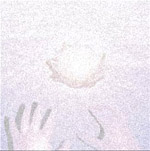|
|
 |
Dusted Reviews
Artist: Dolphins Into the Future Album: The Music of Belief Label: Release The Bats Review date: Mar. 26, 2010 |

|
|
|
 |
While nearly any music can be said to create a mental state or put its listener in a specific headspace, such aims are sometimes stated more unequivocally. Gnawa music, various strains of indigenous trance traditions, and Buddhist chant are made purely for such aims, and in cases like these, the aesthetics of the music can be seen as secondary to a primary spiritual objective. This places the music outside of the realm of conventional aesthetic criticism to some degree, with a definition of “success” largely based on its effect on the performer or listener. It’s a nebulous realm, more reliant on an inner individual response than subjective aesthetic considerations. How then, to consider The Music of Belief, the second album from Dolphins Into the Future? Lieven Martens, the one man behind this one-man band, found his inspiration for the music in devotional texts, making music “to awaken the listener’s inner-seeing or God-vision.” That statement alone may trigger alarm bells for some, but it may be because we’re all just a bit too cynical these days.
Whether one is to take Martens at face value is up for argument; despite his apparently deep interest in the texts that make up his source material, there’s definite likelihood of irony. His reference of the Cetacean Nation (believers in the roles of dolphins and whales in bringing humans to a new level of consciousness) and the general adoption of hackneyed new-age signifiers might suggest a less-than-earnest endeavor into oceanic spirituality. But, motivations be damned: The Music of Belief and its ultra-marine psychedelia can be considered outside of its spiritual core, and it owes much to a new age aesthetic so rife with cultural baggage that the music inevitably conjures thoughts of bargain bin albums with titles like Rain Forest Interlude and Songs of the Humpback Whale.
Martens explores the astral plane as underwater environ via a mix of found sound and synthesizer that remixes new age clichés into a more contemporary package. “The Voice of Incorporeality” gathers things into a crowded foreground mash where the ebb and flow of a slowly modulating synth is overlaid with what sounds to be gurgling water, birds and dolphin calls. For such a pleasant little environment, Martens’ oasis grows surprisingly stagnant over 30 minutes, its pastel exotica relentlessly revolving on a stationary axis.
“Observations Through the Halocine of the Worlds” takes a more discrete approach, with seven segments over 31 minutes. What these vignettes offer in focus, however, doesn’t result in much more for the listener. The shimmering waves and warbling melodies are nice enough, but the track’s seven segments almost will themselves into the background.
For those who find the music’s more spiritual side ignorable or ineffectual (I’d imagine that’s most of us), it doesn’t make for an engaging listen. This problem spans the disc as a whole, and Release the Bats’ last CD release before going to vinyl full-time isn’t a strong digital swansong. Music of Belief transcends little, anchored firmly to the earth, mired in the mundane.
By Adam Strohm
|







